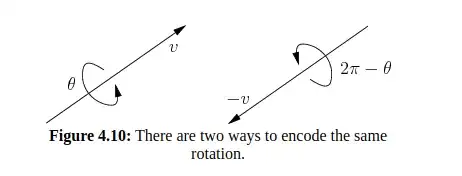I am given the following question: I need to prove that two quaternions map to the same Rotation Matrix in SO3 Space. It is demonstrated by this image:
Let w be v here. I tried to work out the proof, but it isn't coming out correctly:
$Q=(cos\frac{\theta}{2},w.sin\frac{\theta}{2})$
$Q=cos\frac{\theta}{2}+w_{1}.sin\frac{\theta}{2}.\mathbf{i}+w_{2}.sin\frac{\theta}{2}.\mathbf{j}+w_{3}.sin\frac{\theta}{2}.\mathbf{k}$
As per image, replace $\theta$ with $2\pi-\theta$ and w with -w
$Q=cos\frac{2\pi-\theta}{2}+-w_{1}.sin\frac{2\pi-\theta}{2}.\mathbf{i}+-w_{2}.sin\frac{2\pi-\theta}{2}.\mathbf{j}+-w_{3}.sin\frac{2\pi-\theta}{2}.\mathbf{k}$
$Q=-cos\frac{\theta}{2}+w_{1}.sin\frac{\theta}{2}.\mathbf{i}+w_{2}.sin\frac{\theta}{2}.\mathbf{j}+w_{3}.sin\frac{\theta}{2}.\mathbf{k}$
It is not equal! I am left with $-cos\frac{\theta}{2}$ which is not matching. Please tell me how to fix this
